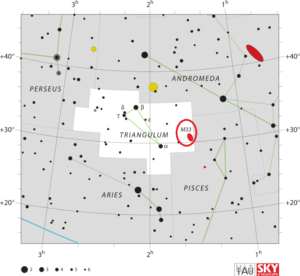Messier 33, otherwise known as the Triangulum galaxy is located 2.7 million light-years away, and the 3rd-largest member of our Local Group, after the Milky Way and Andromeda galaxies.
Messier 33 is believed to be a satellite of the larger Messier 31, the Andromeda Galaxy, based on their proximity, interaction and velocities. The two galaxies are separated by less than 300 kiloparsecs, with M33 being slightly more distant from Earth than Andromeda. A stream of hydrogen gas linking the two objects was discovered in 2004 and confirmed in 2011, which indicates a past interaction between 2 and 8 billion years ago. It expected that M33 and M31 will likely undergo a more dramatic encounter in about 2.5 billion years.
| Description | |
| Visible From Pacific Northwest | September to November |
| Best Time To Observe | October |
| Minimum Size Of Viewing Device | Large Binoculars |
| Object Type | Spiral Galaxy |
| Designations | Messier 33, M33, Triangulum Galaxy, NGC 598, Triangulum Pinwheel, LEDA 5818, 2E 409, PGC 005818, UGC 1117, MCG +05-04-069, 1ES 0131+303, RX J0133.8+3039, RBS 214, TC 906 |
| Right Ascension | 01h 33m 50.02s |
| Declination | +30°39’36.7” |
| Constellation | Triangulum |
| Number Of Stars | 40 billion |
| Apparent magnitude | +5.72 |
| Apparent dimensions | 70′.8 x 41′.7 |
| Object Radius | 60,000 light years |
| Distance From Earth | 2,380,000 – 3,070,000 light years |
History
Messier 33 was probably first discovered by the Italian astronomer Giovanni Battista Hodierna before 1654. Hodierna listed the object as a cloud-like nebulosity near “the Triangle” in his work De systemate orbis cometici; deque admirandis coeli caracteribus (“About the systematics of the cometary orbit, and about the admirable objects of the sky”).
Charles Messier found the object independently and catalogued it on August 25, 1764.
William Herschel catalogued M33 as H V.17 after observing it on September 11, 1784. He described the object as a “nebulosity. not less than 1/2 deg. broad, perhaps 3/4 degree long, but not determined.”
American astronomer Edwin Hubble identified 35 classical Cepheids in M33 in 1926, which allowed him to estimate their distances. The results supported the theory that spiral nebulae were in fact independent galaxies and not just nebulae within the Milky Way.
Locating M33 In The Sky
The easiest way to locate M33 is to start with the Great Square of Pegasus, formed by Alpheratz, Scheat, Algenib and Markab, and trace the three bright stars of Andromeda in the direction of Cassiopeia‘s W shape. Mirach is the middle star along the line. A line drawn from Mirach to Mothallah, the star that marks the apex of the triangle in the constellation Triangulum, leads directly to the Triangulum Galaxy. M33 is located just over halfway along the line. The best time of year to observe the galaxy is in the months of October, November and December.

Viewing M33
The Triangulum Galaxy is best seen in very large binoculars or telescopes at low magnifications. It is a popular target for astrophotographers as its spiral arms and brighter H II regions can be captured with better amateur equipment. Large telescopes will reveal the galaxy’s globular clusters, dust lanes and spiral structure itself.
Photographing M33
The Triangulum Galaxy is a spectacular sight when photographed through a telescope. It’s large, colorful spiral formation has been well-photographed by amateur astrophotographers using a camera and telescope.Through astrophotography, a photographer can reveal the faint details and structure of the Triangulum Galaxy with long exposure images. It is indeed possible to utilize a camera to photograph M33 in an urban backyard.
When imaging M33, it is highly recommended to either utilize a DSLR that has been modified with the stock IR filter removed as the galaxy is made up of a plethora of hydrogen material that won’t really show without some filtering and removal of the IR filter. Capturing narrowband data in the H-Alpha wavelength will brighten these hydrogen rich areas even more.
Adding in HA to the image will make the Triangulum Galaxy look even better. Moreover, it is crucial to make sure that the entire galaxy can be fit into the shot, so make sure to use a telescope that is wide enough to fit it in. Autoguiding will be important with these long exposure shots.
Sources And Further Reading
Descriptions of all of Messier Objects can be found here.
https://www.nasa.gov/feature/goddard/2019/messier-33-the-triangulum-galaxy
https://hubblesite.org/contents/media/images/2019/01/4305-Image.html
https://www.galactic-hunter.com/post/m33-the-triangulum-galaxy

Be the first to comment on "Messier 33 Triangulum Galaxy"